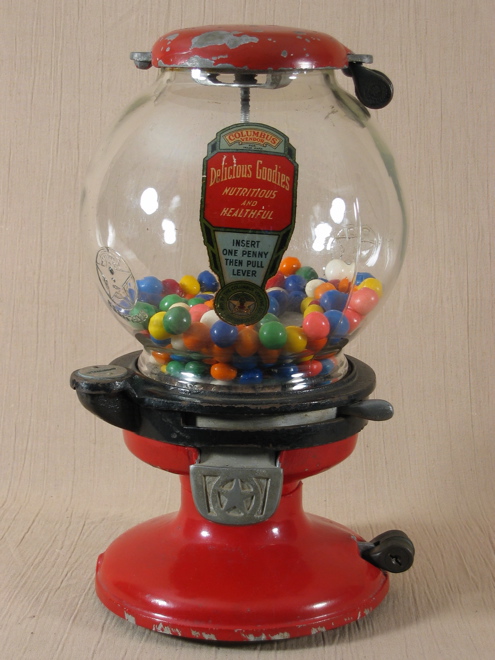___________________________________________________________________________________________
Columbus Model 45G

___________________________________________________________________________________________

Columbus Vending Company, Columbus, OH, c. 1948, 14 1/2. This machine has a good story attached to it, and here it is:
One day I talked to a collector-friend and he told me he'd bought a Columbus 45A but that it was different from the one in Silent Salesmen Too, and he was a little worried it wasn't right. He said that instead of vending candy and peanuts as described in The Book, it dispensed gum, and the gate was short instead of long as pictured in Silent Salesmen Too. He was sure the paint was original, though, which in my opinion is 95% of the battle when it comes to judging a machine's righteousness. I told him that a lot of machines had variations---I was thinking mainly of the gate when I said that---and to relax and enjoy it. If someone did switch the gate sometime in history, it was probably a route guy 50 or 60 years ago, in which case this was still 99.8% correct in my opinion.
A while later I was fortunate enough to buy his collection. When I saw this machine I asked if it was the one we'd discussed, and he said yes. I commented that now that I was seeing it live, there was no question this was all original and "right." I put it on the shelf and posted it to this website calling it a Model 45A with some unique variations. Here's what I wrote about it then:
It's made of aluminum and has a slightly different shape from the cast iron Model A. Silent Salesmen Too says this was never sold under the Columbus name, but instead was developed explicitly for catalog houses. It also mentions that: 1) The model came with a large flap, and 2) It came with padlocks instead of barrel locks. More about that below. Its mechanism and vending wheel are like those of the Columbus Model K; multiple gumball holes are arrayed around the perimeter, the vending wheel moves only clockwise, and the vending lever moves back and forth without a penny and vends only when a penny bridges the gap between the lever and the vending wheel. It's interesting that Columbus went back to this early design on a post-war machine, after years of having a "back and forth" single compartment mechanism like that on their Model A, Model M, and Model 46.
I'm not sure that Silent Salesmen Too can be so definitive about what kind of flap and lock was supplied with this model. I bought this specific machine from a friend who found it in the southeastern United States, and he got it exactly as shown, with the smaller gate and barrel locks. I don't remember the specifics of the find, but I talked to him shortly after he bought this and we both concluded that this had almost certainly never passed through a collector's hands, and that the configuration shown is therefore probably that used at the end of its life in service. That doesn't mean that a vendor didn't alter something while the machine was used on route, but it does mean that it's unlikely that a collector fiddle-futzed with the machine after it was removed from service. If you compare this to the one pictured on page 51 of Silent Salesmen Too, you can also see that the vending lever on the one pictured above slides further to the left than the one pictured in the book. I don't know what significance this has, if any, but it's something I noticed.
Once I unlocked myself from the paradigm that this was a 45A with variations, it was pretty obvious that this isn't a 45A. It's as different from a 45A as a Model 14 is from a Model A---which many early collectors have trouble telling apart, but which become obvious at 40 paces as one gains more experience in such vital societal skills as distinguishing different models of antique vending machines. I know what you're thinking: Some people spend time nuturing their marriages, advancing their careers, and guiding their children's development, and some learn to tell Columbus models apart. I say, to each his own.
But back to the story. This appears to be a rare bird. I doubt most collectors---even most experienced collectors---know this model exists. The other 2 who own one agree with me; neither knows of another beyond the ones we own collectively (although I'm sure at least a couple more exist---we don't know everyone!). Next time you pass a "45A" you may want to slow down and take a good look, especially if it has a short gate. If you don't then you might just be passing up a great opportunity.
___________________________________________________________________________________________
___________________________________________________________________________________________
©Small Vintage Vending 2003-2009